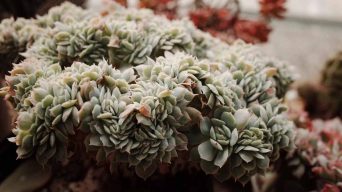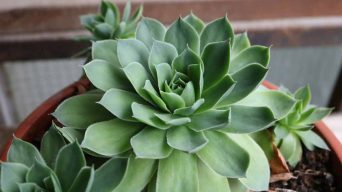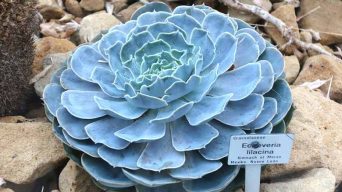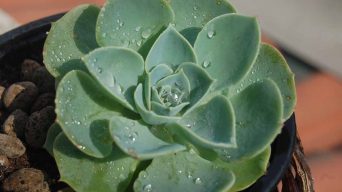Key Takeaways
- Echeveria plants require 4 to 6 hours of bright but indirect sunlight daily for optimal growth; too much or too little can lead to sunburn, dehydration, and weak stems.
- Indoor Echeveria plants should be placed near east or west – facing windows for bright indirect light; artificial lights such as LED grow lights can also provide suitable lighting conditions.
- Outdoor Echeveria plants need at least six hours of direct sunlight per day but must be protected from sunburn through shading during hot summer afternoons and regular watering.
- Other factors affecting Echeveria’s light needs include seasonal changes in sunlight exposure and climate conditions such as temperature and humidity levels.
Echeveria plants, known for their captivating rosettes and vibrant colors, are popular among plant enthusiasts.
Understanding the light requirements of these stunning succulents is essential for achieving optimal growth and maintaining their unique appearance.
In this blog post, we will explore the role of sunlight in Echeveria’s growth process, the ideal amount of light they need to thrive, and tips on providing suitable lighting conditions indoors and outdoors.
How Much Light Do Echeveria Plants Need?
Echeveria plants must receive four to six hours of bright, indirect sunlight daily to grow well.
The Role Of Light In Echeveria Growth
Sunlight plays a crucial role in the growth and development of Echeveria plants.
As succulents, they possess unique characteristics that enable them to store water and nutrients within their fleshy leaves efficiently.
Echeveria plants are known for their stunning rosette-shaped arrangements of leaves and vibrant colors.
To maintain these eye-catching features, they require adequate exposure to bright light.
Insufficient lighting can lead to dull coloration or uneven growth patterns, such as elongated stems (a phenomenon known as etiolation).
For example, when growing Echeveria’ Perle von Nurnberg,’ you may notice that its rich purple hues become more pronounced with sufficient exposure to natural light.
The Optimal Amount Of Light For Echeveria
Echeveria plants, as succulents, thrive in environments with bright but indirect sunlight.
The optimal amount of light exposure for these captivating plants is approximately four to six hours per day.
It’s crucial to find a balance between providing enough light and avoiding overexposure to direct sun rays.
For instance, placing an Echeveria plant near a south or east-facing window can provide adequate natural light without risking damage through scorching sun rays.
Remember that specific echeveria varieties might have different needs – some may cope well in direct sun for short periods, while others require consistent shade during peak summer months.
The Dangers Of Too Much Or Too Little Sunlight
Striking the perfect balance of sunlight exposure for your Echeveria plants is crucial to their overall health and growth.
Too much direct sun can lead to severe issues such as sunburn, manifesting as yellow or brown spots on the plant’s leaves.
On the flip side, insufficient sunlight can adversely impact Echeveria plants by causing them to become leggy and stretch out in search of light.
Low light conditions may also result in lackluster foliage with pale colors and weak stems that cannot support healthy growth.
Moreover, inadequate lighting reduces flowering potential while increasing susceptibility to pests such as mealybugs or spider mites.
Factors Affecting Echeveria’s Sunlight Needs
Various factors, such as changes in seasonal sunlight exposure and climate conditions, can influence the amount of sunlight required by Echeveria plants.
Seasonal Changes In Sunlight Exposure
As the seasons change, it’s important to consider how your Echeveria’s sunlight exposure might be affected.
During the summer months, you may find that your plant needs more shade or less direct sunlight to avoid sunburn and dehydration.
It’s also worth noting that seasonal temperature changes can impact how much light your Echeveria needs.
For example, if temperatures are particularly hot or cold in your area, adjust the amount of light exposure accordingly.
Climate Conditions And Location
The climate and location of your Echeveria plant play a significant role in determining the amount of sunlight it needs.
If you live in an area with high humidity, your Echeveria may require less direct sunlight to prevent overwatering.
Additionally, if temperatures soar above 90 degrees Fahrenheit or drop below freezing (32 degrees or lower), moving your succulent indoors or providing shade during extreme weather conditions is essential.
Providing Appropriate Light For Indoor Echeveria Plants
For your indoor Echeveria plants to thrive, placing them near brightly lit windows facing east or west is essential.
This will prevent sunburn and dehydration.
For more details on providing the perfect amount of light for your indoor Echeveria plants, continue reading.
How To Avoid Sunburn And Dehydration
Proper sunlight is crucial for Echeveria plant growth, but too much or too little can cause sunburn and dehydration.
Here are some tips on how to avoid these issues:
- Gradually increase the amount of sunlight your Echeveria receives over a few weeks to acclimate it to its new environment.
- Place the plant near a south- or west-facing window, but avoid direct midday sunlight when the sun’s rays are the strongest.
- Provide shade during hot summer months using sheer curtains or move the plant into a partially shaded area.
- Monitor the soil moisture and water your Echeveria when the soil has completely dried out. Overwatering can lead to root rot and dehydration due to excessive evaporation.
- Avoid getting water on the leaves, as it can magnify sunlight and burn them.
- If you notice signs of sunburn or dehydration (such as brown spots, wilting, or yellowing), move your Echeveria to a shadier location and reduce watering until it recovers.
These simple precautions can help your Echeveria thrive without risking damage from too much sun or dehydration.
Light Requirements For Indoor Echeveria Plants
Indoor Echeveria plants require as much light as possible, but providing them with the right light is essential.
Direct sunlight can cause sunburn and dehydration, so opting for bright indirect light instead is best.
If your indoor space doesn’t receive enough natural light, artificial lights can imitate sunlight and provide Echeveria plants with the appropriate amount of light they need.
A white fluorescent light placed 6 to 12 inches above the plant can effectively provide the right amount of brightness.
When selecting a potting mix, use a well-drained soil that will allow water to drain away from the roots quickly, preventing root rot caused by overwatering.
Keywords: indoor Echeveria plants, artificial lights, well-drained soil, bright indirect light
Indoor Lighting Options For Echeveria
If your indoor space is not getting enough natural sunlight for your Echeveria plant, several indoor lighting options can provide the necessary light:
- LED grow lights: These lights emit the specific spectrum of light that plants need for photosynthesis and growth, making them an excellent choice for growing indoor Echeveria plants. They are also energy-efficient and long-lasting.
- Fluorescent lights: These are widely available and can be used as an alternative to LED grow lights. However, they do not last as long and are less energy-efficient.
- Incandescent bulbs: These bulbs produce a significant amount of heat that can damage sensitive succulent leaves if placed too close to the plant. They also have a limited lifespan.
- Natural light through windows: If your Echeveria plant is placed near a window, it can receive natural sunlight during the day. However, it’s important to ensure the plant is not exposed to direct sunlight for extended periods, which can cause sunburn and dehydration.
When choosing an indoor lighting option for your Echeveria plant, consider its light requirements, potting soil quality, and watering needs.
Also, remember that each succulent variety may have slightly different lighting needs.
Providing Appropriate Light For Outdoor Echeveria Plants
To keep your outdoor Echeveria plants healthy, they must receive at least six hours of direct sunlight daily.
However, protecting them from sunburn is important, especially during hot summer afternoons.
Keep reading to learn how to balance their sunlight exposure.
Outdoor Light Requirements For Echeveria
If you’re growing Echeveria plants outdoors, it’s important to understand their light requirements.
As mentioned, these succulents thrive in direct sunlight or very bright partial shade.
When planting your Echeverias outside, choose a spot with at least four hours of direct sunlight daily.
If the area is partially shaded, ensure the light is bright for optimal growth.
It’s also crucial to protect your outdoor Echeverias from the harsh sun and prevent sunburn by providing some afternoon shade during the hot summer months.
Tips For Protecting Outdoor Echeveria From Sunburn
One of the biggest dangers for outdoor Echeveria plants is sunburn, which can damage and even kill the plant.
Here are some helpful tips to prevent sunburn:
- Provide shade: If your Echeveria plant receives too much direct sunlight, consider setting up a shade cloth or moving it to a spot that receives partial shade.
- Water regularly: When plants are dehydrated, they are more susceptible to damage from the sun. Ensure you’re watering your Echeveria periodically and deeply so the soil stays moist.
- Use sunscreen: A layer of sunscreen can provide a barrier between the sun and your plant’s leaves. You can make your natural sunscreen by mixing equal parts water and milk and spraying it on the leaves.
- Plant strategically: Choose a spot for your Echeveria with some natural shade during the hottest part of the day, such as under a tree or near a larger plant.
- Keep an eye out: Regularly check your Echeveria for signs of sunburn, such as brown or black spots on the leaves. If you notice any damage, trim away affected leaves to allow new growth to flourish.
These tips help keep your outdoor Echeveria healthy and thriving in even the brightest sunlight!
Outdoor Location Options For Echeveria
Echeveria plants thrive outdoors with plenty of direct sunlight and well-draining soil.
Below are some location options for your Echeveria:
- Patio or Balcony: Echeveria succulents can be placed on a sunny patio or balcony to receive the required amount of light for growth. Just protect them from the harsh afternoon sun, especially during the hot summer months.
- Garden Beds: A well-prepared garden bed can provide the perfect spot for your echeveria plants. Choose a location that receives at least six hours of direct sunlight daily and amend the soil with perlite or sand to ensure adequate drainage.
- Rock Gardens: Echeveria plants look beautiful planted among rocks in rock gardens. These areas typically have excellent drainage and provide plenty of sunlight.
- Window Boxes: Grow Echeveria in window boxes attached to south or west-facing windows outdoors for optimal light exposure.
- Hanging Baskets: Another option is hanging baskets attached to outdoor structures such as pergolas, where they can bask in bright, filtered light all day long.
No matter where you choose to plant your Echeveria, ensure it gets enough sunlight while protecting it from extreme heat or cold weather conditions that could harm its growth cycle.
Final Thoughts
Echeveria plants thrive in bright but indirect sunlight for optimal growth.
Providing them with too much or too little light can harm their health and development.
It is important to consider seasonal changes and the location of your plant when determining its sunlight needs.
Indoor lighting options such as grow lights can be an alternative for proper Echeveria plant growth if natural light isn’t accessible.
Remember to water these beautiful succulent plants appropriately and ensure good drainage for healthy roots.







